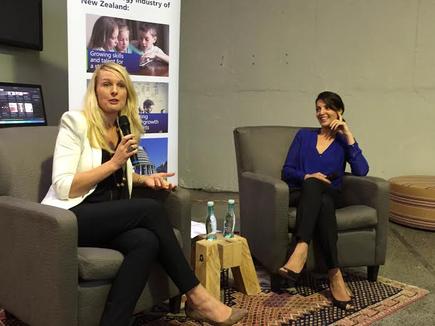
This was a key finding of the recently completed research by the New Zealand Technology Industry Association (NZTech) on one of the top issues in the sector – the under representation of women, particularly at senior levels.
“Whilst it is promising that so many organisations are actively working on the issue, the fragmentation and ad hoc funding may limit the overall impact of these initiatives in the longer term,” according to the report, Advancing women – to provide needed tech sector skills.
“Consolidation of these programmes should result in a wider impact by channelling resources to initiatives that are making a real difference,” the report states. "Together, these programs can be leveraged to grow the long-term talent pipeline."
NZTech recommends that organisations addressing the skills gap should first start by considering which existing initiatives may meet their needs and support those accordingly before launching their own.
“Advancing women is no longer just a corporate social imperative, it is a competitive imperative,” according to the report authors, Graeme Muller, CEO and Jennifer Rutherford, director, member and government relations, of NZTech. NZTech is a not for profit organisation composed of technology companies, educational institutions and startups.
Rutherford explains when she first came in, she wanted to see which programmes for advancing women in the sector were already in place.

Read more: Does your Board paper have a section on cyber risk?
Have a look at what is already there. You may be able to help or volunteer for these programs.
"We are taking this paper to the people who are already working in the industry, like the Ministry of Education and the Ministry of Women’s Affairs.
“We all know the problem and looked at how many fragmented programs there are. Let us get together.”
Rutherford says the long-term goal is to get an agreement from the people who are involved in solving this issue, and “get some consolidation around programmes that can scale better and deliver better outcomes.”
The report underscores why addressing this issue is a national imperative.
Read more: 'How to take the mind-set of a startup’
It points out various global research showing how gender balance in technology improves financial results in companies. One of these is the 2013 report Why Diversity Matters by Catalyst, a not for profit that focuses on diversity in the workplace. The report assessed the link between gender diversity in senior management and company financial performance in Fortune 500 companies. The key finding was that women in leadership roles increased return on equity by at least 53 per cent and return on sales by at least 42 per cent.
And yet, locally, women make up only 23 per cent of those employed in IT occupations and only 28 per cent of all roles across the technology sector in New Zealand, according to the 2013 Census.
The number of women planning to enter the sector is also declining with only 3 per cent of 15-year-olds in New Zealand considering a career in computing professions, according to the report.
A recent NZTech survey among its members estimated a shortfall of more than 10,000 skilled staff that will be needed by the sector in the next three years. Given that the national tertiary system produces just over 2,000 computer science graduates per year, this leaves a sizeable shortfall, the report states.
Currently, this is in part being offset by sourcing offshore, but this can only be an interim measure, says the report. With a global talent shortage this method will soon become increasingly costly and challenging.
Read more: Movers and shakers: Lois van Waardenberg is new Plunket CIO
The report likewise notes 12 years of age is a critical time for encouraging female students’ interest in computer sciences. “Career aspirations become apparent before students enter high school, which supports the idea that learning at primary school level is valuable, but that it also needs to be a positive experience.”
“Everyone I bump into are sort of fired into an enthusiastic mode and starts to do something different,” says Rutherford, when faced with these statistics.
“My recommendation is to take that enthusiasm and don’t start something new because we have got too many initiatives. Have a look at what is already there. You may be able to help or volunteer for these programs.”
Women make up only 23 per cent of those employed in IT occupations and only 28 per cent of all roles across the technology sector in New Zealand, according to the 2013 Census.
Read more: CEOs: Shortage of digitally skilled staff reaches ‘crisis level’
Some of the projects cited in the report are: Skill Finder (for increasing the immediate talent pool); Dev Academy and Industry Connect (for retraining or preparing a currently available workforce); Summer of Tech, ICETech 360 and ICT Grad Schools (for preparing and placing graduates) ; Future in Tech, High Tech Youth Network, TechHub (was ICT Connect), OMG Tech, Code Club Aoteoroa, Gather Workshops, Kiwibots and The Mindlab (for developing future talent ).
Programmes encouraging women and addressing diversity in IT include Computer Chicks, STEAM Ahead, Shadow Tech Day, Fantail Network, Geek Girls Dinners, Global Women, Maori ICT development fund, National Advisory Council of Women, NZ Tech Women, Refactor Tech Girls (CPIT), TPK Maori Cadetship, W initiative, Women on Boards, Women’s mentoring programme at the University of Auckland, and Westpac Women of Influence Awards.

Related: ‘This article on diversity is not about gender imbalance’
Nonlinear progression
Rutherford joined NZTech early this year, following 10 years as regional sales manager for Cisco. Before this, she held a range of roles for various technology firms.
As to what worked for her, she says, having been brought up with a “really strong sense of justice…that I could do anything I wanted to do” was a key factor.
She says more than 20 years in the sector has shown her nurturing a career in ICT is “not always a straight line”.
“I have had children and that has impacted on the career opportunities that have been available to me, and I have stepped back from opportunities that were put in front of me because of the impact they would have had on my family."
Read more: 'Few NZ organisations can claim to truly have a diverse workforce': Hays Report
“I found roles and positions that have worked for me,” she says. “Sometimes, I have taken some sideways moves.”
She does agree with Facebook chief operating officer Sheryl Sandberg, who had espoused tackling career advancement as a ‘jungle gym’, not a ladder.

“There’s only one way to get to the top of a ladder, but there are many ways to get to the top of a jungle gym. The jungle gym model benefits everyone… The ability to forge a unique path with occasional dips, detours and even dead ends presents a better chance for fulfilment,” Sandberg wrote in Lean In. “Plus, a jungle gym provides great views for many people, not just those at the top. On a ladder, most climbers are stuck staring at the butt of the person above.”
Rutherford is emphatic about the importance of getting good mentors and executive sponsors.
“This has been key in getting opportunities to advance….I have also had excellent training and personal development opportunities through working for companies like IBM, HP and Cisco.”
She says these companies gave her access to high level professional development which helped her progress and grow her capabilities.
Related:The unsung women of technology
Send news tips and comments to divina_paredes@idg.co.nz
Follow Divina Paredes on Twitter: @divinap
Follow CIO New Zealand on Twitter:@cio_nz
Sign up for CIO newsletters for regular updates on CIO news, views and events.
Join the CIO New Zealand group on LinkedIn. The group is open to CIOs, IT Directors, COOs, CTOs and senior IT managers.
